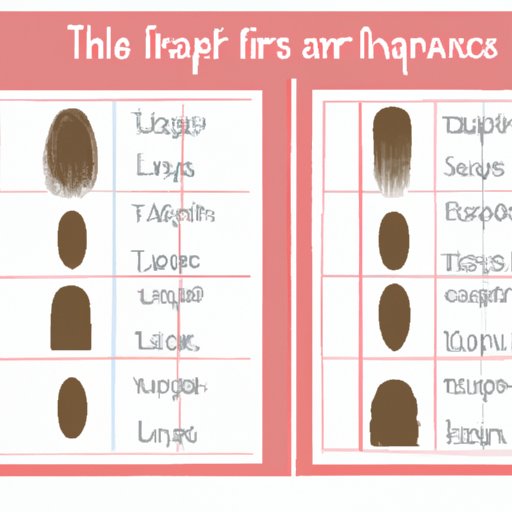
Introduction
Many people struggle to determine what type of hair they have. It can be confusing to understand the different textures, thicknesses, and levels of frizz that are associated with each type of hair. However, once you know your hair type, you can better care for it and choose products and styling tools that work well for you. In this article, we provide a comprehensive guide on how to determine your hair type.
Overview of Hair Types
The four main types of hair are straight, wavy, curly, and coily. Straight hair is typically the thinnest and most lustrous, while wavy hair has a slight bend and can range from fine to coarse. Curly hair is characterized by defined curls that can be tight or loose, while coily hair is very tightly curled with a zig-zag pattern. Each type of hair has its own defining characteristics, including texture, thickness, and level of frizz.
Strand Test
The best way to determine your hair type is through a strand test. To do this, start by isolating a small section of hair near the nape of your neck. Wash this section without any products and let it air dry. Once dry, examine the natural texture and shape of the hair. This will give you a good indication of the type of hair you have, including its curl pattern and level of frizz.
Quiz
If you don’t want to conduct a strand test, you can take a quiz to determine your hair type. Here are some questions to ask yourself:
- What is the texture of my hair?
- How does my hair behave in humidity?
- What is my hair history (i.e. chemical treatments)?
- How do I usually style my hair?
Use the answers to these questions to determine your hair type. For example, if your hair is flat and struggles to hold a style, you may have straight hair. Oily roots and dry ends can indicate wavy or curly hair, while tight curls suggest coily hair.
Common Hair Problems
Common hair problems can also give clues to your hair type. For example:
- Oily roots and dry ends can indicate wavy or curly hair
- Flat hair that struggles to hold a style suggests straight hair
- Frizz that worsens in humidity can indicate wavy, curly, or coily hair
If you experience these problems, chances are you have the corresponding hair type.
Visuals
Visuals are a great way to compare and contrast different hair types. Use pictures of real people or illustrations to show the key differences between straight, wavy, curly, and coily hair. Seeing examples can help you recognize the characteristics of your own hair.
Caring for Each Hair Type
Once you know your hair type, it’s important to care for it properly. Here are some tips:
- Straight hair: Use lightweight products that won’t weigh down your hair, and avoid heavy oils and styling products. Consider using a dry shampoo to keep your hair looking fresh between washes.
- Wavy hair: Use gentle products that won’t strip your hair of its natural oils, and avoid heavy products that can weigh down your waves. Use a diffuser when blow-drying to enhance your natural wave pattern.
- Curly hair: Use moisturizing products to keep your curls hydrated, and avoid sulfates and alcohol, which can dry out your curls. Use a microfiber towel or cotton t-shirt to dry your hair, as regular towels can cause frizz.
- Coily hair: Use moisturizing products that will help define your curls and combat dryness. Avoid products with harsh chemicals and sulfates, which can strip your hair of its natural oils. Use a wide-tooth comb or your fingers to detangle your hair.
Conclusion
Determining your hair type is essential for proper hair care. Whether you conduct a strand test, take a quiz, or use visual examples to identify your hair type, once you know it, you can start caring for your hair in the best possible way. By following our comprehensive guide, you can learn how to manage each hair type and avoid common mistakes that can damage your hair.




